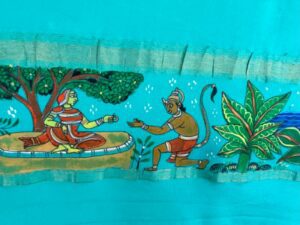Alia Bhatt was draped in a turquoise blue Mysore silk saree from the shelves of Bengaluru's clothing label Madhurya Creations.

Eight scenes from the Ramayana were chosen to depict on the saree. (Supplied)
What happens when spirituality and sartorial needs meet at one of the most historic moments in India? The Internet juxtaposes pictures of the Ram temple opening with photographs of a leading Bollywood actress defining a Ramayana moment for fashion.
Alia Bhatt was among the many celebrities invited to attend the Ram Mandir consecration ceremony on 22 January, 2024 at Ayodhya. On this day, Bhatt was seen in a traditional avatar, draped in a turquoise blue Mysore silk saree from the shelves of Bengaluru’s clothing label Madhurya Creations.
While Bhatt did justice to the traditional dress code for the day, it is her Ramayana-themed blue saree that has been painting the town red.
Young, unique and appropriate for the event were the instructions for Bengaluru-based designer Bharathy Harish, founder of Madhurya, when she received a call from Bhatt’s stylist Ami Patel.
“Ami told me to create something unique with a new concept for Alia to wear for the inauguration. Since Ayodhya is in Uttar Pradesh and the popular weave there is Banarasi, Ami asked me to share options with Banarasi weave too,” shares Harish with South First.
Aware that she was one of the several options for Bhatt’s traditional ensemble, Harish knew her design had to foster the fervour of the ceremony. Focus on the process, not on the outcome, Harish reminded herself.
“We realised that creating a Ramayana-themed saree was apt for the occasion. But, at the same time, we were also aware that the saree had to be worn respectfully. We will be judged for every aspect of the saree creation. So, we decided to use an existing, traditional art form which constantly depicts our grand epics through Kalamkari, Pattachithra art forms,” she shares.
The pallu is the place of pride in any saree, says Harish. Most traditional handwork is created on the pallu which acts as a stage to showcase every artisan’s work.
The work had to be delicate, subtle, with a message that is communicated, but not overbearing, she adds.
The process began by picking the saree colour. “We decided to go with blue because Lord Rama is typically depicted in that hue. It also resembles a fresh, young sky,” notes Harish, who started Madhurya Creations more than a decade ago.
The next step was to choose prominent scenes from the Ramayana. Each Kanda of Valmiki Ramayana has crucial events. Of these, eight were chosen, she shares.
“The first is the Bala Kanda in which the most joyous and significant event is the Sita swayamvara, followed by the breaking of the Siva dhanush, marriage of Lord Ram and Sita. The other turning point in this Kanda is the exile of Lord Rama. An important scene here is Lord Rama taking the blessings of his father, King Dasharatha,” explains Harish.
This is followed by the depiction of King Guha on the Ganga with Lord Rama, Lakshmana and Sita on the boat. “This is an iconic scene as it represents devotion. Next is appearance of the golden deer in Panchavati, Sita crossing the Lakshmanrekha after which Ravana abducts her. Then comes the Choodamani Pradhanam where Hanuman meets Sita and presents Lord Rama’s ring to her in Ashoka Vatika, which is trailed by the construction of Ram Setu bridge, and finally, Lord Rama’s Pattabhishekam.
With scenes confirmed, Harish chose a simple Mysore silk with a traditional pallu which has a three-inch gap between the zari lines. “We had to showcase the intricate tapestry within this framework. The highlight of the saree is the nuanced handpainted work within these lines,” she informs.

New Delhi-based veteran Pattachitra artist recreated the scenes and brought them to life on the saree. (Supplied)
Having settled on the weave, the scenes and the choice of artwork, Harish reached out to Sujit Behara, a New Delhi-based veteran Pattachitra artist to recreate the scenes and bring them to life on the saree.
“Pattachitra is a traditional art form; the style is pre-defined. It seemed to match the mood of the occasion,” adds Harish, who is a graduate from BITS Pilani.
Racing against time, Behara was instructed to achieve the work in three days that would otherwise require 10 days. “I told him to pray and accomplish it along with his wife, who is also a Pattachitra artist,” recalls Harish.
Without further ado, Behara and his wife worked on it diligently. The saree was ready in less than 100 hours and shipped to Mumbai.
“Ami loved the saree and the concept. We were thrilled to be selected for the D-day,” shares Harish. Her phone has been buzzing ever since with congratulatory messages.
Calling Kanjivaram and Uppada as her favourite weaves, Harish recognises that several factors combine in making a weave popular. “The same red dye, the same silk yarn will be different in Kanjivaram and Banarasi weaves. It will feel different because the mineral content of the Cauvery river is different from the Ganges. That makes a huge difference in the outcome of the colour and the way a saree shines,” she informs.
Harish believes that there is a need for scientific reappraisal and awareness about the heritage of weaves. While Benarasi weave is versatile, she vouches for South Indian weaves. At Madhuraya, which is a single store that collaborates with over 1000 artisans, all the proceeds go towards the support of girl children, informs Harish.
“There is a spirit of social enterprise in the work we do,” she shares.
It is with this spirit that the ilk of Bharathy Harish is weaving ways to sustain, preserve and promote the vibrant traditional weaves of India.

Jul 26, 2024

Jul 21, 2024

Jul 20, 2024

Jul 20, 2024

Jul 19, 2024

Jul 18, 2024